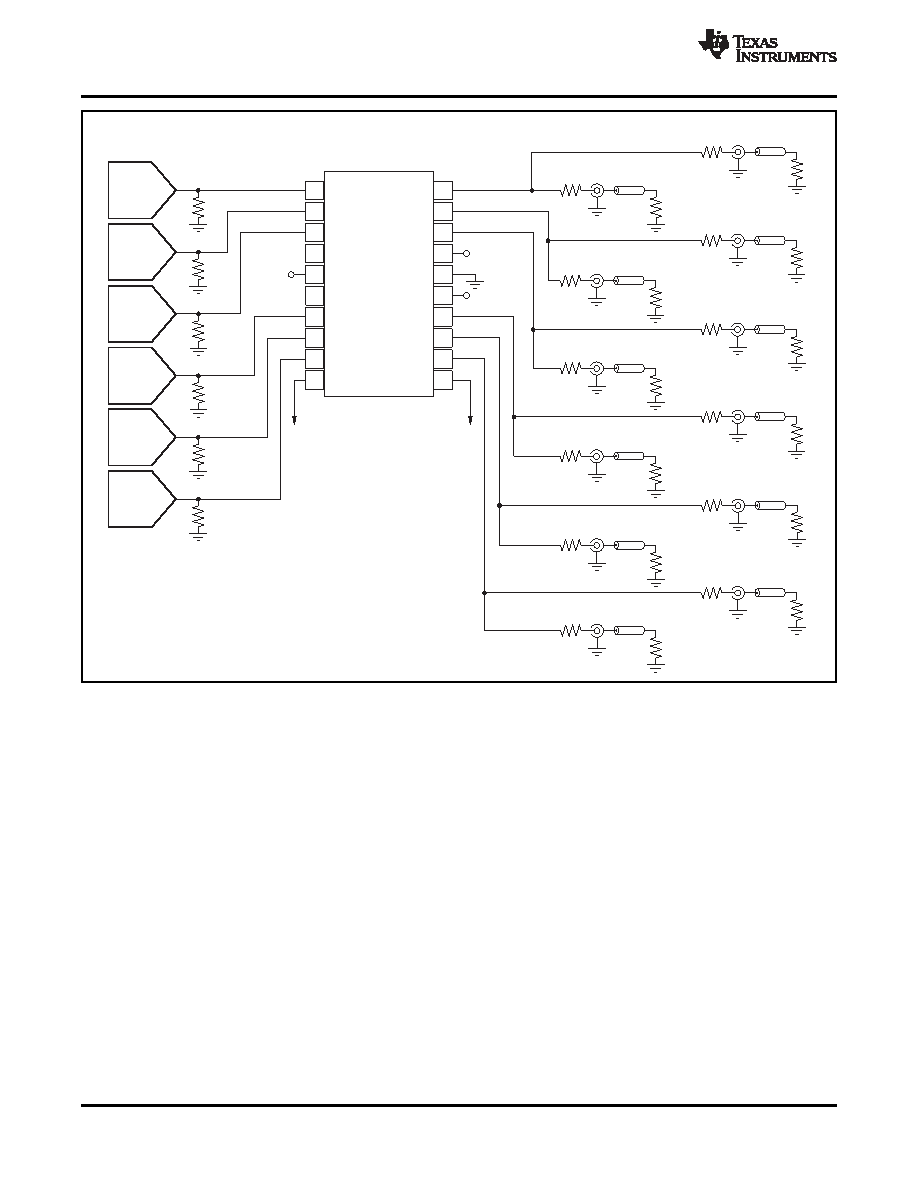- 您現(xiàn)在的位置:買賣IC網(wǎng) > PDF目錄98229 > THS7360IPW (TEXAS INSTRUMENTS INC) VIDEO AMPLIFIER, PDSO20 PDF資料下載
參數(shù)資料
| 型號: | THS7360IPW |
| 廠商: | TEXAS INSTRUMENTS INC |
| 元件分類: | 音頻/視頻放大 |
| 英文描述: | VIDEO AMPLIFIER, PDSO20 |
| 封裝: | GREEN, PLASTIC, TSSOP-20 |
| 文件頁數(shù): | 21/43頁 |
| 文件大小: | 962K |
| 代理商: | THS7360IPW |
第1頁第2頁第3頁第4頁第5頁第6頁第7頁第8頁第9頁第10頁第11頁第12頁第13頁第14頁第15頁第16頁第17頁第18頁第19頁第20頁當(dāng)前第21頁第22頁第23頁第24頁第25頁第26頁第27頁第28頁第29頁第30頁第31頁第32頁第33頁第34頁第35頁第36頁第37頁第38頁第39頁第40頁第41頁第42頁第43頁

75 W
S-VideoY'1Out
CVBS1Out
CVBS
R
SOC/DAC/Encoder
S-Video Y’
R
S-Video C’
R
Y'/G'
R
1
2
3
4
5
6
7
8
9
10
20
19
18
17
16
15
14
13
12
11
SD1OUT
SD2OUT
SD3OUT
DisableSD
GND
DisableHD
SF1OUT
SF2OUT
SF3OUT
BypassSF
SD1IN
SD2IN
SD3IN
NC
V
S+
NC
SF1IN
SF2IN
SF3IN
BypassSD
THS7360
Bypass
SDLPF
Bypass
SFLPF
P' /B'
B
R
P' /R'
R
75 W
S-VideoC'1Out
75 W
Y'/G'1Out
75 W
P’ /B'1Out
B
75 W
P' /R'1Out
R
75 W
S-VideoY'1Out
CVBS1Out
75 W
S-VideoC'1Out
75 W
Y'/G'1Out
75 W
P' /B'1Out
B
75 W
P’ /R'1Out
R
75 W
+2.7Vto
+5V
DisableSF
DisableSD
SLOS674 – JUNE 2010
www.ti.com
(1) SF indicates selectable filter.
Figure 47. Typical Six-Channel System with DC-Coupled Line Driving and Two Outputs Per Channel
One concern of dc-coupling arises, however, if the
but power and thermal analysis should always be
line is terminated to ground. If the ac-bias input
examined in any system to ensure that no issues
configuration is used, the output of the THS7360 has
arise.
Be
sure
to
use
RMS
power
and
not
a dc bias on the output, such as 1.6 V. With two lines
instantaneous power when evaluating the thermal
terminated to ground, this configuration allows a dc
performance.
current path to flow, such as 1.6 V/75
= 21.3 mA.
Note that the THS7360 can drive the line with
The result of this configuration is a slightly decreased
dc-coupling
regardless
of
the
input
mode
of
high-output voltage swing and an increase in power
operation. The only requirement is to make sure the
dissipation of the THS7360. While the THS7360 was
video line has proper termination in series with the
designed to operate with a junction temperature of up
output (typically 75
). This requirement helps isolate
to +125°C, care must be taken to ensure that the
capacitive loading effects from the THS7360 output.
junction temperature does not exceed this level or
Failure to isolate capacitive loads may result in
else long-term reliability could suffer. Using a 5-V
instabilities with the output buffer, potentially causing
supply, this configuration can result in an additional
ringing
or
oscillations
to
appear.
The
stray
dc power dissipation of (5 V – 1.6 V) × 21.3 mA =
capacitance that appears directly at the THS7360
72.5 mW per channel. With a 3.3-V supply, this
output pins should be kept below 20 pF for the fixed
dissipation reduces to 36.2 mW per channel. The
SD filter channels and below 15 pF for the selectable
overall low quiescent current of the THS7360 design
minimizes potential thermal issues even when using
the TSSOP package at high ambient temperatures,
28
Copyright 2010, Texas Instruments Incorporated
Product Folder Link(s): THS7360
相關(guān)PDF資料 |
PDF描述 |
|---|---|
| THS7364IPWR | 6 CHANNEL, VIDEO AMPLIFIER, PDSO20 |
| THS7364IPW | 6 CHANNEL, VIDEO AMPLIFIER, PDSO20 |
| THS7365IPWR | 6 CHANNEL, VIDEO AMPLIFIER, PDSO20 |
| THS7365IPW | 6 CHANNEL, VIDEO AMPLIFIER, PDSO20 |
| THS7368IPWR | 6 CHANNEL, VIDEO AMPLIFIER, PDSO20 |
相關(guān)代理商/技術(shù)參數(shù) |
參數(shù)描述 |
|---|---|
| THS7360IPW | 制造商:Texas Instruments 功能描述:VIDEO AMPLIFIER IC |
| THS7360IPWR | 功能描述:視頻放大器 6-Channel Video Amp RoHS:否 制造商:ON Semiconductor 通道數(shù)量:4 電源類型: 工作電源電壓:3.3 V, 5 V 電源電流: 最小工作溫度: 最大工作溫度: 封裝 / 箱體:TSSOP-14 封裝:Reel |
| THS7364 | 制造商:TI 制造商全稱:Texas Instruments 功能描述:6-Channel Video Amplifier with 3 SD and 3 Full-HD Filters with 6-dB Gain |
| THS7364_10 | 制造商:TI 制造商全稱:Texas Instruments 功能描述:6-Channel Video Amplifier with 3 SD and 3 Full-HD Filters with 6-dB Gain |
| THS7364EVM | 功能描述:放大器 IC 開發(fā)工具 THS7364 Eval Mod RoHS:否 制造商:International Rectifier 產(chǎn)品:Demonstration Boards 類型:Power Amplifiers 工具用于評估:IR4302 工作電源電壓:13 V to 23 V |
發(fā)布緊急采購,3分鐘左右您將得到回復(fù)。